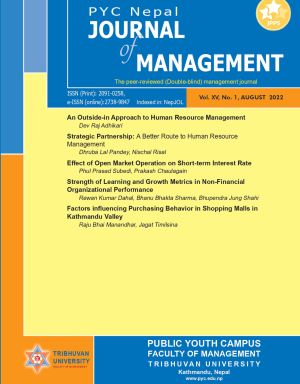Strategic Partnership: A Better Route to Human Resource Management
DOI:
https://doi.org/10.3126/pycnjm.v15i1.56362Keywords:
Open market operations, Repo, Reverse repo, Short-term interest rates, Monetary policyAbstract
The organization of human resources has currently supposed strategic importance in the fulfillment of organizational development and distinction. Companies and organizations are looking for ways to build a strategic partnership between employees and employers. The main objective of the study is to identify factors that help human resources become more of the strategic partner and to examine whether strategic partnership leads to organizational effectiveness or not. In order to fulfill this objective, numerous articles have been reviewed. The researchers compared and contrasted the findings of various articles to identify the common factors that contributed HR to becoming a strategic partner. The extensive review of the literature revealed that human resource planning and development are the most crucial factor for strategic partnership, while other factors do not contribute much to the strategic partnership. Regarding organizational effectiveness, most of the studies showed that HR departments that offer value by acting as a business partners are the most successful.
Downloads
Downloads
Published
How to Cite
Issue
Section
License
© Public Youth Campus

